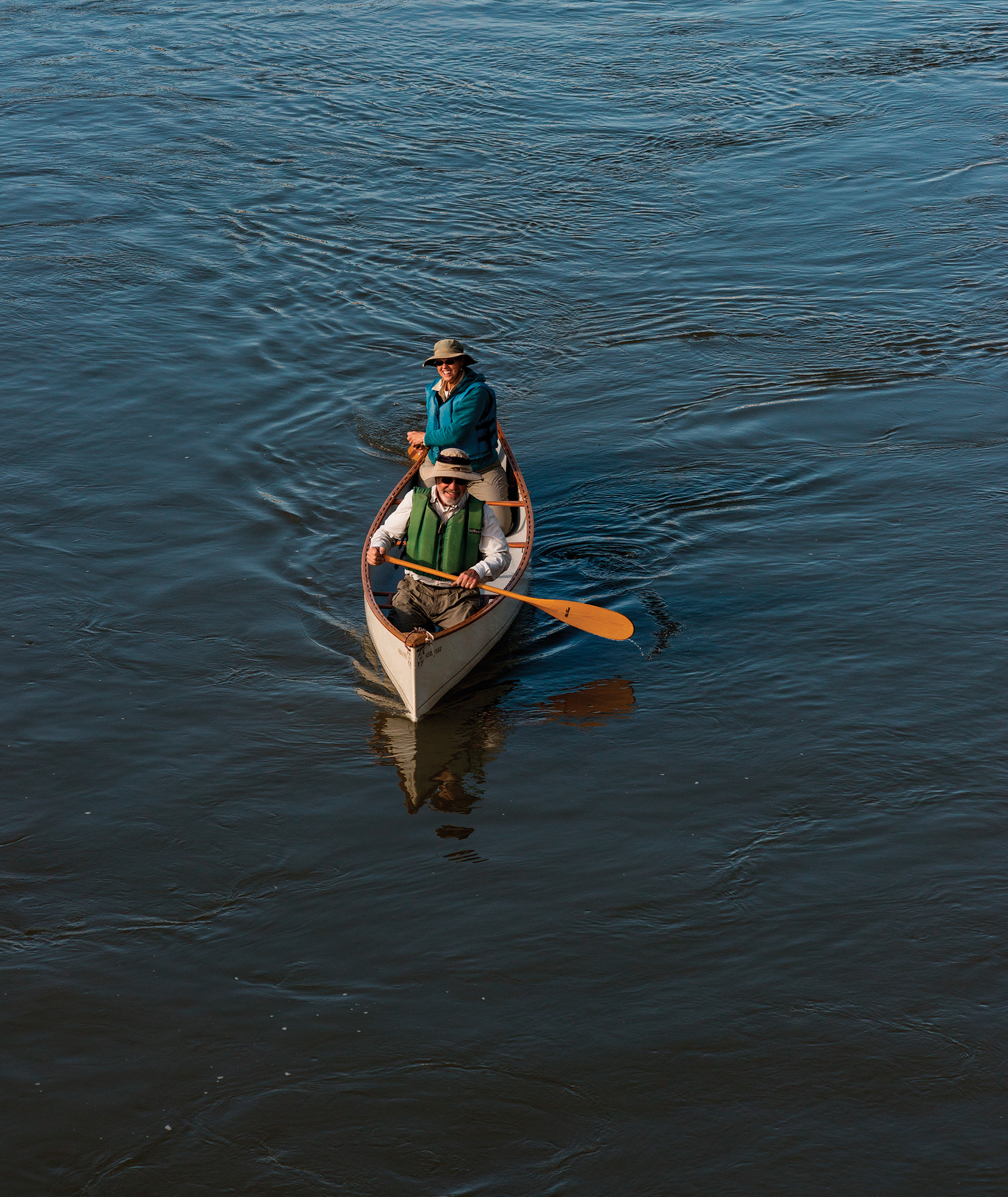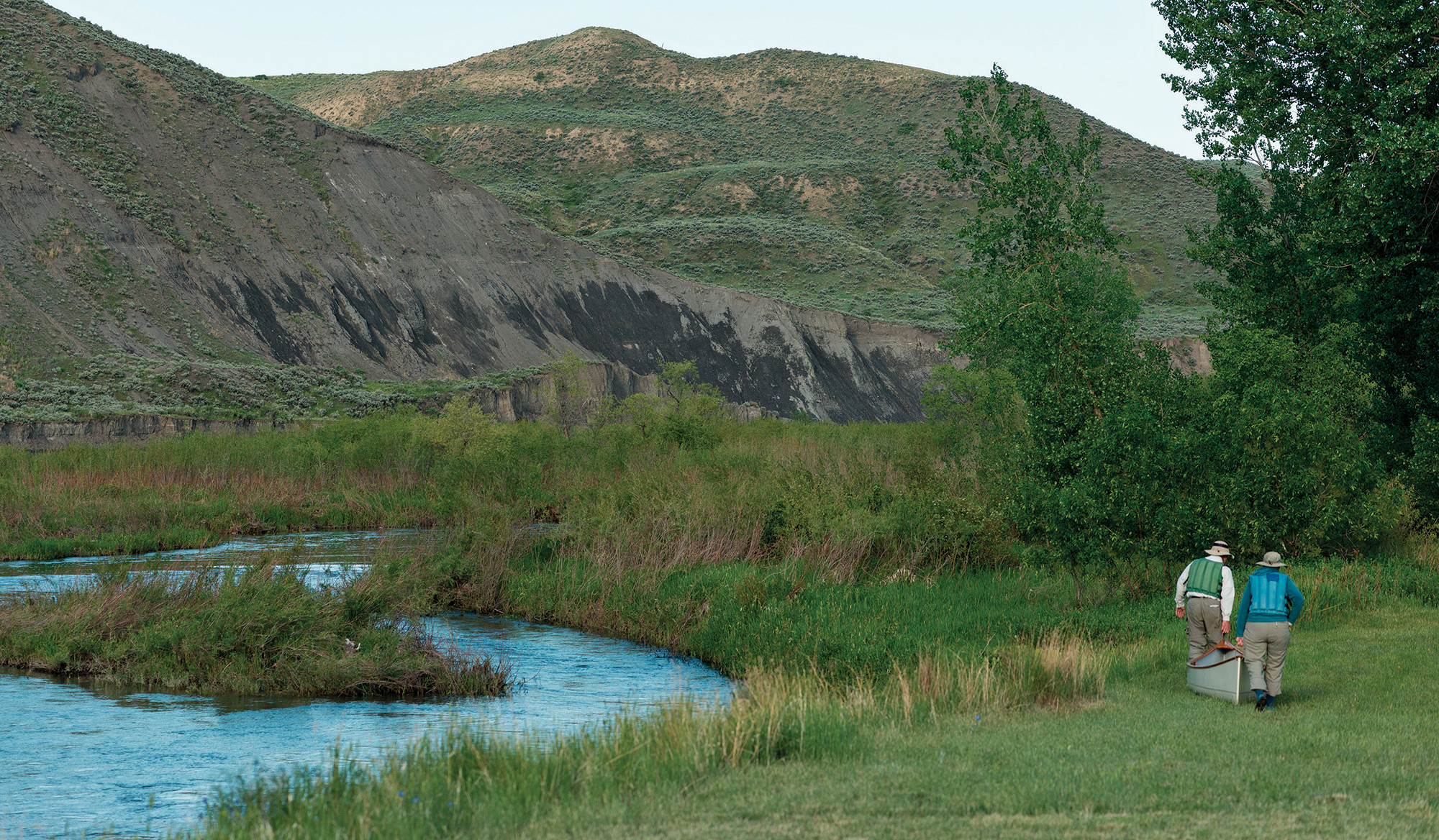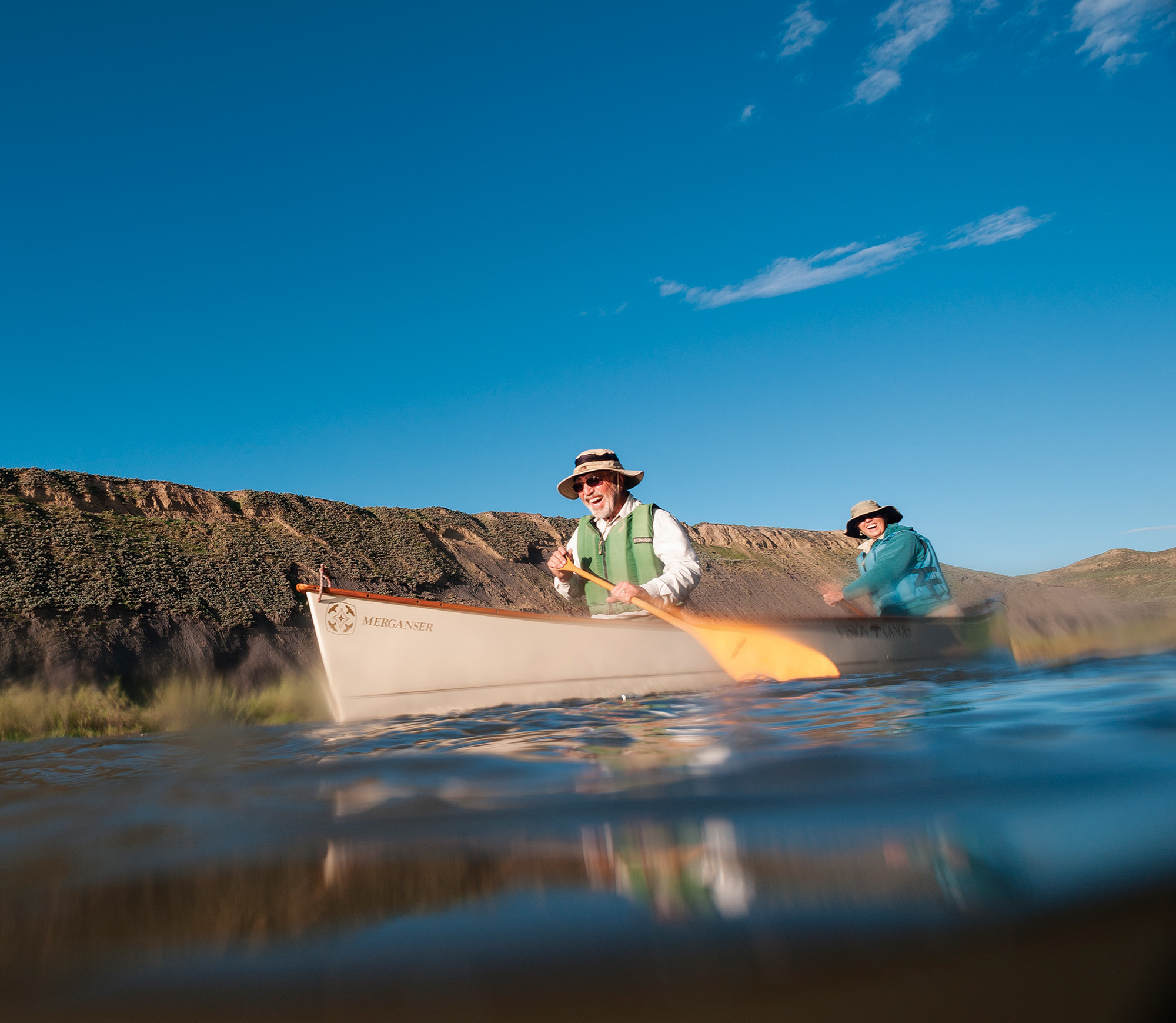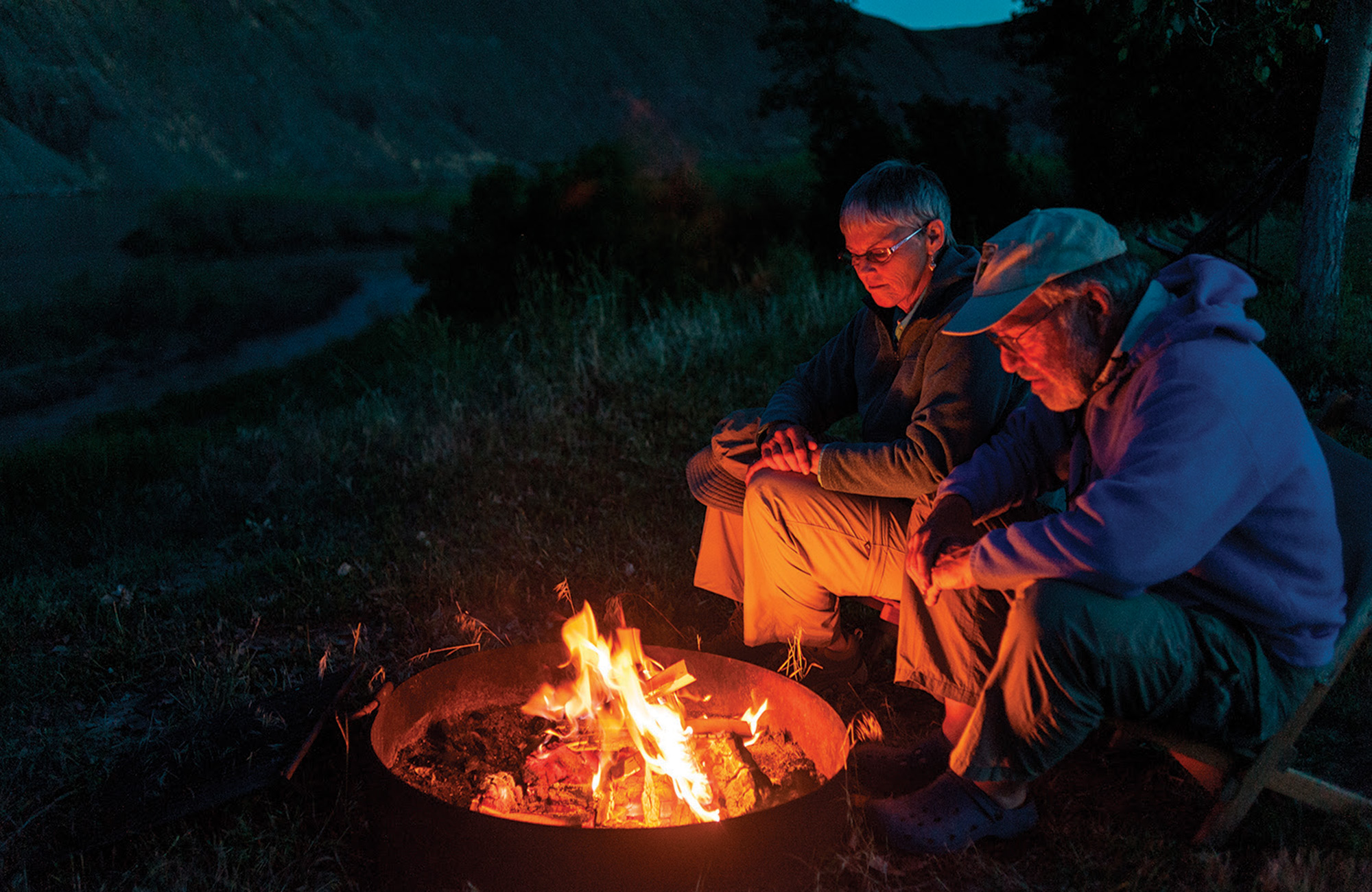
05 Oct Checking The River
JIM GREENE AND MARTHA VOGT’S SECOND DATE took place in a canoe. They lived in Missoula, Montana, back then, and Greene invited Vogt to see a heron rookery on the Clark Fork River outside of town.
“We got in the boat that day and I saw that she knew how to hold a paddle and take a stroke,” Greene remembers. “That made an impression.”
Turns out that Vogt grew up paddling rivers and lakes in Michigan, where most people had a canoe in the backyard, but Greene upped the ante, introducing her to whitewater. Their second date initiated a relationship that evolved around canoes on the Blackfoot, Clark Fork, and Bitterroot rivers. Time teamed up in boats together also served as the metaphor for their relationship, their deepening ties to nature, and a partnership based on teamwork and communication.
“Whenever life has been hard,” says Greene, “we tell each other to ‘keep the paddles in the water.’”
Not much has changed over the decades in that regard. These are folks who you don’t ask what they do for a living, but rather, where their next adventure is taking them.
On summer mornings at Coal Banks Landing, where Vogt and Greene (now in their 60s and 70s) work as seasonal river hosts, they are up before dawn. They grab a couple of camp chairs and head down to their favorite spot on the bank, where the Missouri River slides by, full of its inexorable power and mystery.
“We make a point, every day, to greet the sun. It’s absolutely quiet,” says Greene. “You can hear a woodpecker drumming on a tree across the river.”
“We watch young birds being raised over the weeks,” adds Vogt. “It feels like ceremony. We call it, ‘checking the river.’ It is a very spiritual thing. The older we get, and the more friends we lose through the years, the more spiritual it becomes.”
Their workday is punctuated by chores and by parties showing up to launch on the Wild and Scenic portion of the Missouri. Greene and Vogt check people in, answer questions, share photos of campsites, gauge the competence of each group, and try to respond appropriately.
“You get the whole gamut, from people who are completely comfortable and skilled, to folks who think they can make the trip floating in an inner tube,” says Greene.
“Some people we’ve stayed in touch with over the years,” says Vogt. “You never know who will show up — folksingers from British Columbia, a family from Switzerland.”
“Maybe 10 times a summer, kayakers come through who are out to do the entire Missouri and Mississippi down to the Gulf,” adds Greene.
Around 5 p.m., they close up shop and stroll upriver for the bookend to their daily river ceremony, a cooling float back home. Depending on the day and the temperature, they might repeat the swim a couple of times.
“We just float along and see where we are,” Greene says.
When they have a window of extra time, they might take a canoe upriver to Loma or the Virgelle Ferry crossing and paddle back down. And each summer, Greene tries to find that fleeting window of adequate flow on the nearby Teton River for a two- or three-day float.
The depth of feeling for this geography that they share with visitors goes back to 1995, when Vogt and Greene took their first long canoe trip through the Wild and Scenic segment of the Missouri River together, and fell in love with the country. They took along James Willard Schultz’s Floating on the Missouri, a classic account of a late fall trip Schultz took with his Blackfeet wife, Natahki, in 1901. Back then, it was a river still populated by reclusive “wood hawks” cutting fuel for the steamboat companies, a river full of migrating geese and snow squalls, a river before dams or highway bridges. Vogt and Greene read sections of the book to each other as they paddled down those same bends.
“Every time back we see new things,” says Greene. “The weather is always different, the water levels, and we notice things we haven’t before.”
With each trip, they also come to know each other more deeply.
“Teamwork is a beautiful thing,” says Vogt, “when you make a sweet eddy turn together, or come into shore just right, or work together setting up camp. It can go the other way, too. If we’re not in a good space together emotionally, it doesn’t tend to go so well!”
During the offseason, they travel around the West or spend time in their modest Helena, Montana, home, which doubles as a shrine to their passion: wooden Grey Owl paddles propped in room corners, framed quotes from The Wind in the Willows, a Carl Wimar print of Indians Crossing the Upper Missouri. Upstairs are jars with dried beaver scat, raptor pellets, turtle shells, a bag of goldeneye feathers. The banister on the stairway is a beaver-gnawed branch. Clyde Aspevig’s The Passage hangs on one wall, a landscape of the wild portion of the Missouri River near Hole in the Rock.
Out in the garage, hang four canoes, each meticulously maintained. Wood gunwales, cane seats, paddles resting across the thwarts, boats for flatwater and rapids, solo and tandem, ready for the next trip, redolent with memories of past ones.
Greene and Vogt’s job as seasonal Bureau of Land Management (BLM) campground and river launch hosts fits into a lifelong pattern of service and an appetite for knowledge that has been the hallmark of their lives.
For the past four years, they have been involved in a project with the Montana Preservation Alliance, documenting every one- and two-room schoolhouse in each county in the state. It is a daunting task. In Choteau County alone there are nearly 200 qualifying schools. Each one brims with local history, family stories, local tragedy and triumph, tidbits of quaint lore waiting to be revealed.
They have also served on the board of the Friends of the Missouri Breaks National Monument, worked with BLM archaeologist Zane Fulbright, and have taken part in Lewis and Clark activities like locating historic campsites, celebrating anniversaries, and matching locations with journal descriptions.
“We keep finding reasons to go back,” Vogt laughs. “It’s really kind of selfish.”
“That river has given us so much,” adds Greene. “When I check someone in at the river launch, I always tell them to take their time. I even discourage them from taking books to read because it distracts from the experience.”
Their curiosity-driven immersion into the history and lore of the Missouri connects them in profound, tangible ways to the land and events that wind back through time.
“One year we were on Cow Island on September 23, the same day the Nez Perce crossed on their flight toward Canada in 1877. I remember we ran aground in some shallows and I thought, that’s why they crossed here,” says Greene. “We like to think about Lewis and Clark pulling up the river, 15 miles a day. They were tougher back then. What they did was truly incredible.”
“I’m actually even more drawn to the Indian sites,” says Vogt. “When you find teepee rings it’s always a perfect spot, with a breeze to keep the bugs down, the best views to see things coming.”
“It makes me think of that Charlie Russell painting about the Indians discovering Lewis and Clark,” says Greene. “Russell was really good at providing perspective on the social context as well as the landscape.”
When Vogt and Greene climb into the canoe together, Vogt takes the stern and Greene mans the bow. “Most times we’ve gotten in trouble in the canoe, we’ve been switched. Now, if things look dicey, we always change back to our preferred positions.”
They have paddled together for so long, toward so many horizons, that very little needs to be said. Mile after mile, strokes in sync, the wide sky overhead, and the cliffs and coulees beckoning. Along the way they stop to explore, walking up draws, checking out old buildings, noticing birds and wildlife, finding nature’s tidbits.
In Schultz’s book, Natahki talks about the water spirits in the big, swirling eddies. “I always make a point of saying hello to those spirits,” says Vogt.
Greene keeps meticulous logs of the trip logistics — mileage, weather, water levels — while Vogt’s journals record the day’s events, her emotions, and new discoveries.
“We’ve gotten sort of exclusive,” Greene admits. “We hardly like to go with anyone else. It’s so simple and complete and quiet with the two of us. We just take what comes and deal with it. It’s a kind of religion, being on the water. Whatever higher power exists, that’s where I feel it.”
In a framed quote from Kenneth Grahame’s The Wind in the Willows hanging next to the front door of their home, Vogt and Greene sum things up.
“The river … What it hasn’t got is not worth having, and what it doesn’t know is not worth knowing.”
Not bad for a life’s creed. All it needs is a canoe.
- Vogt and Greene’s seasonal gig on the Missouri River allows for daily doses of river time and plenty of opportunity for contemplation, two important ways this couple count themselves wealthy.
- Paddling together provides metaphors for success in a relationship that has lasted decades, and a partnership premised on the motto: “When things get rough, keep your paddle in the water.”
- Vogt and Greene’s seasonal gig on the Missouri River allows for daily doses of river time and plenty of opportunity for contemplation, two important ways this couple count themselves wealthy.
- Paddling together provides metaphors for success in a relationship that has lasted decades, and a partnership premised on the motto: “When things get rough, keep your paddle in the water.”








No Comments